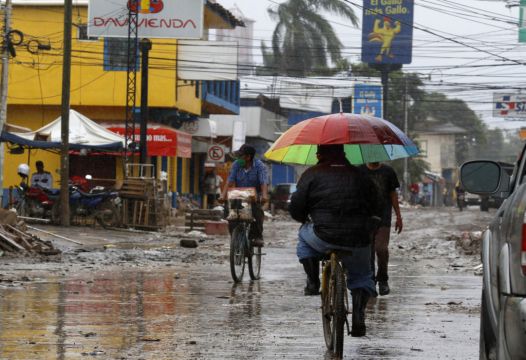The front edge of powerful Hurricane Iota began battering Nicaragua’s Caribbean coast on Monday night, threatening catastrophic damage to the same part of Central America already battered by equally strong Hurricane Eta less than two weeks ago.
Iota had intensified into an extremely dangerous Category 5 storm early in the day, but the US National Hurricane Centre said it weakened slightly by Monday night to Category 4, with maximum sustained winds of 155 mph.
It was centred about 30 miles south of the Nicaraguan city of Puerto Cabezas, also known as Bilwi, and moving westward at 9 mph.
Iota was hitting the Caribbean coasts of Nicaragua and Honduras with torrential rains and strong winds while the western edge of the storm began battering the Nicaraguan coast.

Authorities warned that Iota would probably come ashore over areas where Eta’s torrential rains saturated the soil, leaving it prone to new landslides and floods, and that the storm surge could reach 15 to 20 feet (4.5 to 6 metres) above normal tides.
In Bilwi, business owner Adan Artola Schultz braced himself in the doorway of his house as strong gusts of wind and rain drover water in torrents down the street.
He watched in amazement as wind ripped away the metal roof structure from a substantial two-story home and blew it away like paper.
“It is like bullets,” he said of the sound of metal structures banging and buckling in the wind.
“This is double destruction,” he added, referring to the damages wrought by Eta just 12 days earlier.
Cairo Jarquin, Nicaragua emergency response project manager for Catholic Relief Services, had just visited Bilwi and smaller coastal communities on Friday.

In Wawa Bar, Mr Jarquin said he found “total destruction” from Eta. People had been working furiously to put roofs back over their families’ heads, but now Iota threatened to take what was left.
“The little that remained standing could be razed,” he Jarquin said. There were other communities farther inland that he was not even able to reach due to the condition of roads.
Evacuations were conducted from low-lying areas in Nicaragua and Honduras near their shared border through the weekend.
Nicaraguan Vice President Rosario Murillo, who is also the first lady, said that the government had done everything necessary to protect lives, including the evacuation of thousands.
She added that Taiwan had donated 800 tons of rice to help those affected by the storms.
Iota is the record 30th named storm of this year’s extraordinarily busy Atlantic hurricane season.
It is also the ninth storm to rapidly intensify this season, a dangerous phenomenon that is happening increasingly more often.
Such activity has focused attention on climate change, which scientists say is causing wetter, stronger and more destructive storms.
Iota is stronger, based on central pressure, than 2005′s Hurricane Katrina and is the first storm with a Greek alphabet name to hit Category 5, Colorado State University hurricane researcher Phil Klotzbach said.
It also sets the record for the latest Category 5 hurricane on record, beating the record set by the November 8, 1932 Cuba Hurricane.
Eta had hit Nicaragua as a Category 4 hurricane, killing more than 130 people as torrential rains caused flash floods and mudslides in parts of Central America and Mexico.

Then it meandered across Cuba, the Florida Keys and around the Gulf of Mexico before slogging ashore again near Cedar Key, Florida, and dashing across Florida and the Carolinas.
Iota was forecast to drop 10 to 20 inches (250-500 millimetres) of rain in northern Nicaragua, Honduras, Guatemala and southern Belize, with as much as 30 inches (750 millimetres) in isolated spots.
Costa Rica and Panama could also experience heavy rain and possible flooding, the hurricane centre said.
Over the past couple of decades, meteorologists have been more worried about storms like Iota that power up much faster than normal.
They created an official threshold for this rapid intensification — a storm gaining 35 mph in wind speed in just 24 hours. Iota doubled it.
Earlier this year, Hannah, Laura, Sally, Teddy, Gamma, Delta, Zeta and Iota all rapidly intensified. Laura and Delta tied or set records for rapid intensification.
The official end of the hurricane season is November 30.







